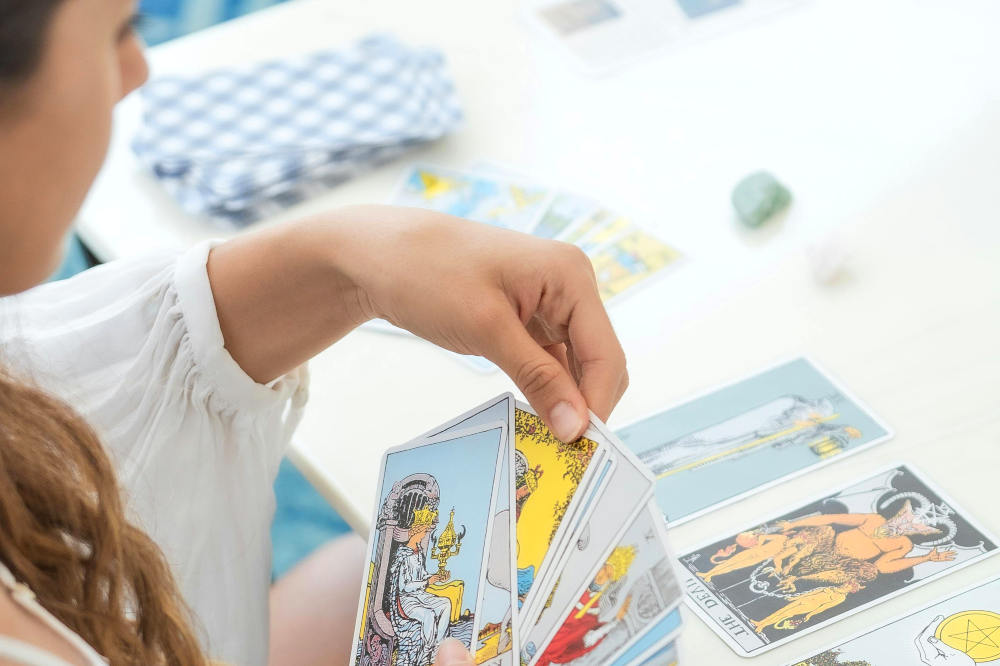
Tarot cards have long been used as tools for insight, intuition, and spiritual growth. But beyond the spreads and readings, many tarot enthusiasts explore deeper ways of connecting with their decks — including one particularly curious practice: sleeping with tarot cards under your pillow.
Is there any benefit to this? Does it help strengthen intuition, bond with your deck, or even invite prophetic dreams? In this article, we’ll explore the origins, beliefs, and possible psychological and energetic reasons behind this practice, along with how to do it safely and meaningfully.
Panaprium is independent and reader supported. If you buy something through our link, we may earn a commission. If you can, please support us on a monthly basis. It takes less than a minute to set up, and you will be making a big impact every single month. Thank you!
What Does It Mean to Sleep with Tarot Cards?
Sleeping with tarot cards typically involves placing a card (or an entire deck) under your pillow or beside your bed before going to sleep. The idea is that your subconscious mind, which becomes more active during sleep and dreams, may connect more deeply with the energy, symbolism, or message of the card.
Some people use this practice to:
-
Receive dream messages or insights related to the card
-
Bond with a new tarot deck
-
Deepen intuition or psychic awareness
-
Set an intention for healing or guidance while sleeping
-
Manifest specific energies, such as strength, clarity, or peace
Where Did This Practice Come From?
There’s no official origin story for sleeping with tarot cards, but the concept ties into several longstanding mystical and psychological traditions:
1. Dream Incubation in Ancient Cultures
In ancient Egypt and Greece, dream incubation was practiced in sacred temples. People would sleep in designated areas hoping to receive divine dreams or visions. Tarot sleeping can be seen as a modern form of this — using a card as a symbolic gateway to access the unconscious.
2. Symbolism and Archetypes (Jungian Psychology)
Carl Jung believed that symbols and archetypes — like those found in tarot — could help us access the unconscious mind. Tarot cards contain rich visual language that speaks to the subconscious, and placing them under your pillow might activate this symbolic connection while dreaming.
3. Energetic Bonding and Spiritual Ritual
Many spiritual practitioners believe that everything carries energy, including tarot decks. Sleeping with a card or deck is sometimes recommended as a way to energetically “attune” the deck to your personal frequency, especially when it’s new.
Potential Benefits of Sleeping with Tarot Cards
While not scientifically proven, many tarot readers report powerful or meaningful experiences from this practice. The benefits are mostly spiritual, psychological, or symbolic in nature.
1. Strengthening Your Connection to the Deck
If you’ve recently bought a new tarot deck, sleeping with it can help you bond with its energy. Think of it as spending intimate time with a new friend — the more connected you feel, the more natural and intuitive your readings become.
2. Enhancing Dream Messages
Placing a specific card under your pillow — like The Moon (associated with dreams and the subconscious) or The High Priestess (linked to intuition) — can invite dreams aligned with that card’s energy. Some people report receiving symbols or answers through dreams tied to the card’s theme.
3. Setting a Nightly Intention
Choosing a tarot card before bed can act as an intentional ritual. For example, sleeping with the Four of Swords may promote rest and recovery, while the Strength card might offer emotional resilience. This nightly practice can shift your mindset and influence your energy while you sleep.
4. Activating Intuition
As we sleep, our analytical mind quiets and our intuition rises. By inviting the energy of a tarot card into this receptive state, we may open new pathways to intuitive growth or healing.
Are There Risks or Downsides?
Sleeping with tarot cards is generally harmless, but there are a few things to consider:
1. Overstimulation of the Subconscious
Tarot cards contain powerful symbols. For sensitive or highly intuitive individuals, sleeping with certain cards (like The Tower or Nine of Swords) might stir up intense dreams or emotional unrest. It’s important to choose cards that feel comforting or empowering, especially at night.
2. Projecting or Overanalyzing Dreams
Some people might place too much weight on dream imagery or try to force meaning where there isn’t any. Not all dreams are profound messages — some are simply mental processing. Approach dream insights with curiosity, not obsession.
3. Physical Discomfort
Practically speaking, sleeping on top of a deck can be uncomfortable. If you want the deck near you without lying directly on it, place it beside your pillow or on your nightstand.
How to Sleep with Tarot Cards: Simple Guide
If you're curious to try this practice, here’s a simple step-by-step guide:
1. Cleanse the Deck or Card
Use smoke (like sage or incense), sound (like a chime), or intention to clear any lingering energy. This helps set a clean slate for the night.
2. Choose Your Card
Pick a card that resonates with your current question, desire, or emotional state. Trust your intuition, or draw one at random.
Example choices:
-
The Star – Hope and healing
-
The Lovers – Relationships or choices
-
The Hermit – Inner wisdom
-
Temperance – Balance and peace
3. Set an Intention
Before sleep, hold the card and silently or aloud state your intention. For example:
“I ask for peaceful dreams and clarity about my next steps.”
4. Place the Card Mindfully
You can:
-
Place it under your pillow (inside a soft cloth if desired)
-
Slide it under the mattress near your head
-
Place it on your nightstand
5. Keep a Dream Journal Nearby
In the morning, write down any dreams, feelings, or insights that came up during the night — even if they don’t make sense at first. Over time, patterns may emerge.
Alternative Methods
If placing the actual card under your pillow feels too intense or uncomfortable, try these alternatives:
-
Meditate with the card before bed
-
Place a digital image of the card under your pillow
-
Put the deck in a soft pouch beside your bed
-
Sleep with a crystal linked to the card’s energy (e.g., amethyst for The High Priestess)
What Do Practitioners Say?
Many experienced tarot readers report that sleeping with a card deepens their connection to the deck and opens intuitive pathways.
“When I was bonding with a new deck, I slept with it for a week. My dreams were vivid and strange, but I woke up feeling closer to the cards — like they understood me better,” says tarot reader Anaïs Luna.
Others recommend using this method sparingly — during spiritual transitions, full moons, or moments of reflection.
“It’s like a dream spell,” explains intuitive healer Marcus Leigh. “You’re planting a seed in your subconscious with the energy of the card.”
Is There Scientific Support?
There’s no clinical research specifically on sleeping with tarot cards. However, there is research supporting the benefits of:
-
Rituals before sleep (shown to improve sleep quality)
-
Dream journaling (linked to increased self-awareness)
-
Symbolic imagery and meditation (used in therapeutic practices to explore the unconscious)
Tarot, in this sense, can be a powerful symbolic ritual that taps into our psychological and emotional processes — especially during sleep.
Final Thoughts: Should You Try It?
Sleeping with tarot cards isn’t for everyone — but it can be a powerful personal ritual if approached with intention, openness, and care.
If you’re curious, start slowly. Choose cards that bring peace, comfort, or strength. Trust your body and your dreams. Over time, you may find that this practice helps you develop a deeper, more intuitive relationship with your cards and yourself.
Like all spiritual tools, the key isn’t in the cards — it’s in the energy and intention you bring to them.
Was this article helpful to you? Please tell us what you liked or didn't like in the comments below.
About the Author: Alex Assoune
What We're Up Against
Multinational corporations overproducing cheap products in the poorest countries.
Huge factories with sweatshop-like conditions underpaying workers.
Media conglomerates promoting unethical, unsustainable products.
Bad actors encouraging overconsumption through oblivious behavior.
- - - -
Thankfully, we've got our supporters, including you.
Panaprium is funded by readers like you who want to join us in our mission to make the world entirely sustainable.
If you can, please support us on a monthly basis. It takes less than a minute to set up, and you will be making a big impact every single month. Thank you.































0 comments